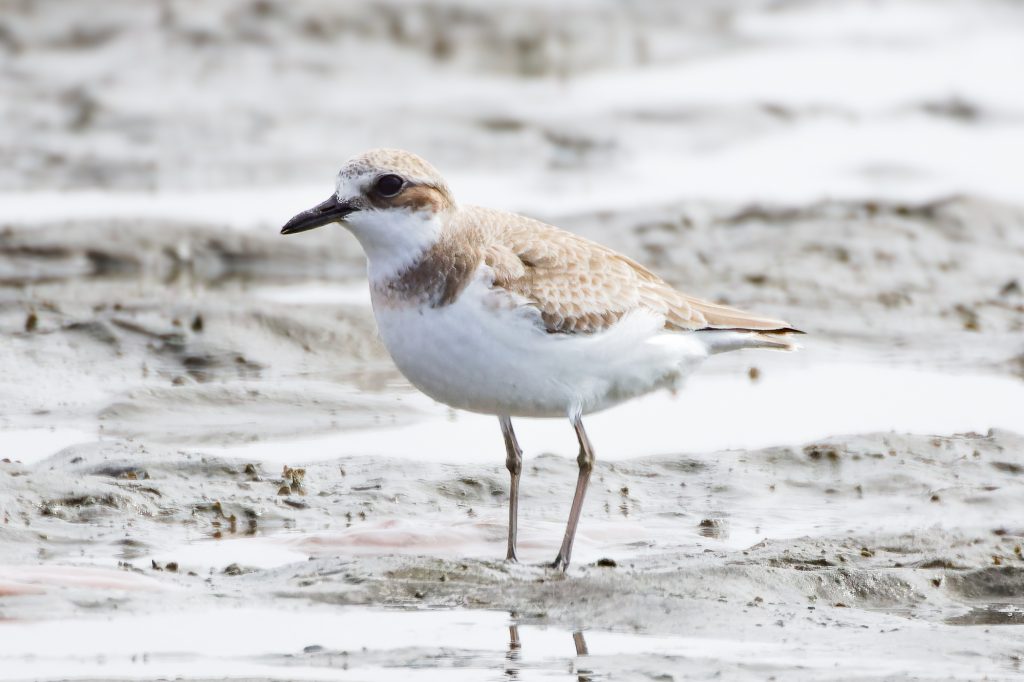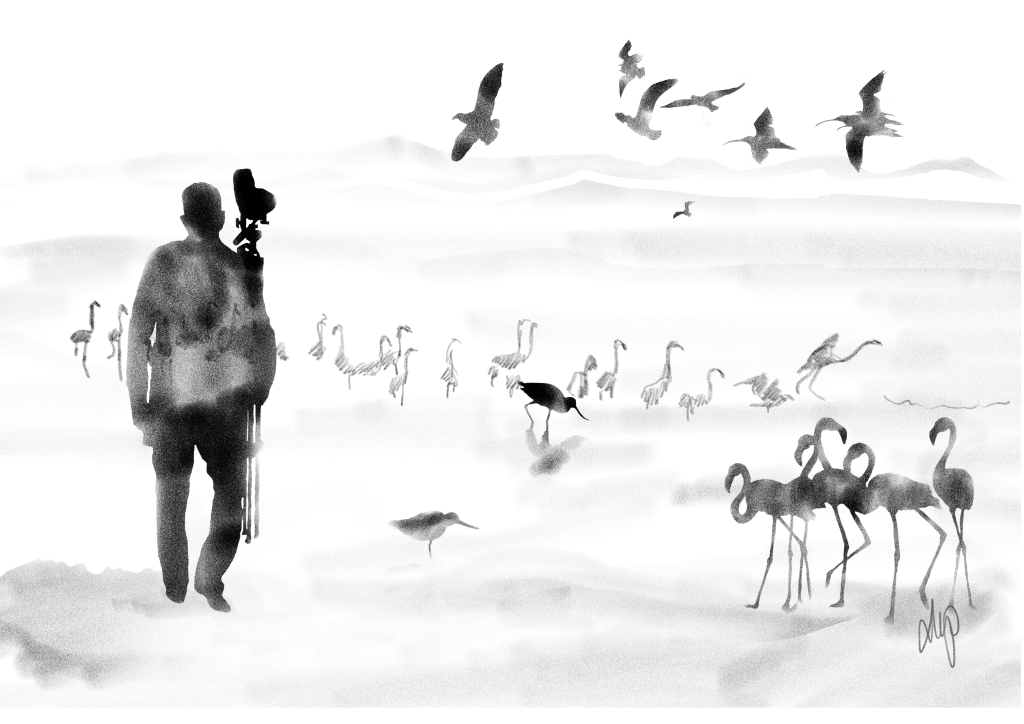“Zugangst” is a German term describing the restlessness of birds preparing to migrate. In the UNESCO World Heritage Site of Walvis Bay Lagoon, a gathering of colours and a sense of preparation for departure settle in.
Thousands of diverse waders hurriedly extract worms from the soil, peck at small mollusks, and plunge their long bills—some upwards, others curved downwards—deep into the rich black mud. They need to top up their energy reserves before their stomachs shrink and rely solely on stored fat during the long flight.

Calidris alba

Ardea cinerea, grey

Xenus cinereus
Almost daily, the Birding WhatsApp group, though sometimes bothersome, alerts me to oversized congregations of Red Knots, larger groups of Terek Sandpipers, and the splendid wedding attire of godwits, sanderlings, sandpipers, and Turnstones. When reports of the Greater Sand Plover sightings flooded in recently, I found myself, amidst piled-up office work, heading “just for a quick visit to the lagoon,” as I casually explained to Lisa. My wife is accustomed to it, knowing it will take longer, and covers my back all day.
However, genuine excitement eludes me nowadays; I’m no longer naively optimistic, but rather viewing things through gray-tinted lenses, no pun intended and not referring to my glasses.
Thousands of flamingos bathe, pump, feed, and chatter before me, though they should have migrated inland by now. But with almost no rain and another looming drought over Namibia, when will these droughts finally end? The inland pans are dry, and every flamingo must remain at the coast; thus, in 2024, there will be no tower-building and egg-laying, almost standing, for incubation.



I am deeply concerned about the migration of these waders. A notable Namibian naturalist bluntly stated, “We as humans are messing up the planet at an alarming speed, and we are doing a pretty good job covering it up.” Several lagoons, tidal flats, and vital feeding grounds for migratory birds have been drained, polluted, or exploited for rare minerals and oil. With local politicians, contracts for exploitation are signed “on an equal footing,” and after a supposedly “nature-friendly feasibility study,” yet another habitat is lost… Growth comes at a cost. I hope the cynicism in the last sentence was evident!
Indeed, these birds rightfully experience Zugangst, a term signifying migratory restlessness or fear, as this word has gained profound significance over time.
I wonder if my children will ever stand here and witness this natural spectacle… probably not.
Suddenly, many tourists gather around me, and flashy off-road vehicles line up, ready to “chase” these adventure-hungry individuals through the dunes, eventually to marvel at the stunning view of dunes meeting the sea at Sandwich Harbour.
I grab my spotting scope, camera, and wade into the lagoon, eager to escape… it’s low tide, and there’s life above me; Hartlaub’s gulls complain at my presence; below me, the lugworms are puzzled by my heavy footprint; behind me, there’s touristy laughter, shouting, and joking; and before me, a seemingly endless variety of birds.
Eventually, calm prevails, and in the distance, the only sounds are industrial hammering and steaming from the port, fuelled by the ever-growing demand for energy and ores. Thanks to Western and Far-Eastern demand, Namibia may look forward to future prosperity, or perhaps not?
As you peer through the spotting scope and slowly scan the flat shores, the colours of various breeding plumages stand out vividly. The migratory birds don their wedding attire, as my colleague Daine recently put it. I’m delighted to see the Greater Sand Plover hopping through the mud, catching small prey in the sand. Too bad it’s not in breeding plumage; maybe it’s a female… whatever. It’s interesting due to its rarity, though inconspicuous, still somehow awesome. (By the way, it turned out that I had a female bird in slight breeding plumage in front of me, kudos to Lightroom)


Terek Sandpipers are easy to photograph, and I’m amazed by their super yellowish-orangy legs and that “boat-shaped” bill, which is probably very practical because the sandpipers almost bury their bills up to the base in the mud. Nice.
Whenever a Grey Plover flies by, I hope for rare Golden Plovers, but all fly-bys have “German armpits.” Indeed, the dark spots under their wings indicate the unshaved armpits of some “Germans,” and so another funny birding term was coined… sorry for that, I know it’s unfair. They are beautiful, though, the males of the Grey Plovers, and trendy too, because black-white-gray always works and is considered very chic.
I won’t photograph many flamingos today; I wouldn’t know which one of the 120,000+ to capture on my hard drive… both species, lesser and greater flamingos, are in close proximity, nearly touchable.

Calidris minuta

Pluvialis squatarola

My new glasses annoy me; multi-focal lenses are a true pain in the backside since the lens still darkens in foggy conditions; unfortunately, the mud is dark as well, and so is the water… man, getting older is becoming a nuisance now.
I fold up my tripod and head home, alone, as apparently, no one else is foolish enough to admire beautiful birds. And I wonder if these tourists have already puked in the backseat due to all the ups and downs in the dunes or if they’re already marvelling at the fantastic nature at Sandwich Harbour with a gin and tonic in hand… As a safari provider, you ponder, because maybe I should offer something like that instead, since it’s obviously what “the people” want.
Yet today, I am the winner, having had the fantastic nature and numerous observations all to myself, which I’ll gladly show my guests! In September, another birding tour is planned… fully booked, I can understand, birding adds meaning to life, it’s as easy as that. Try for one of the safaris next year.
I’m aware that today is a farewell, farewell and fly well, you pretty ones… but in August-September, many will fly back home because even if there’s no nesting here, Africa is always home… for everyone.
Last Updated on 31. May 2024 by Albert Voigts von Schütz





